Decorating the ancestral altar with beautiful flower arrangements is a meaningful way to show respect and devotion to your ancestors. It also adds a warm and solemn touch to the worship space. In this article, Long Phuong Porcelain shares 15 simple and elegant altar flower arrangement ideas to help you choose the perfect style to honor your family traditions.
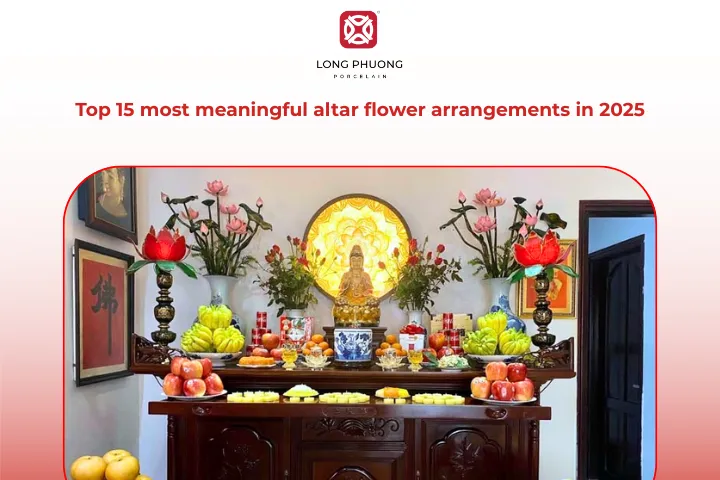
1. The meaning of arranging flowers on the ancestral altar
Flowers are an essential part of ancestral offerings in Vietnamese tradition. While their value may seem small, they carry deep meaning. A beautiful vase of flowers placed alongside offerings shows respect, sincerity, and gratitude from descendants to their ancestors.
In Buddhism, flowers carry an additional meaning. Seeing flowers reminds people to cultivate virtue, and when the flowers are beautiful and free from harm, they symbolize the promise of a good future reward. For these reasons, altar flower arrangement is an indispensable practice during important occasions such as festivals and the Lunar New Year.

2. 15+ beautiful and meaningful altar flower arrangement ideas
2.1. Pure altar arrangement with lotus
The lotus symbolizes purity, nobility, and enlightenment. A lotus flower arrangement on the altar expresses respect, reverence, and the wish for peace and serenity. You can choose white or pink lotus flowers in an upright, elegant style and pair them with lotus leaves for a harmonious and graceful look.

2.2 Meaningful altar arrangement with gladiolus
Gladiolus symbolizes gratitude, filial piety, and prosperity. With their tall, upright stems, a gladiolus arrangement adds elegance and solemnity to the altar. When arranging gladiolus on the ancestral altar, they are often placed in straight bouquets or fan shapes, combining colors like red, yellow, and pink to enhance both beauty and the sense of good fortune.
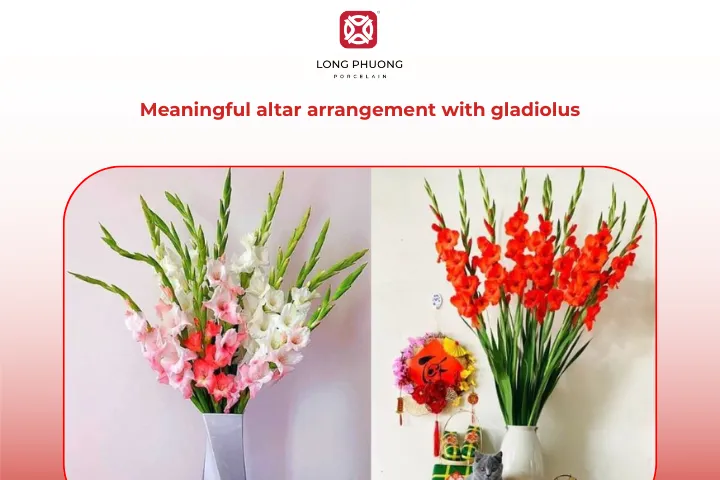
2.3 Graceful altar arrangement with lisianthus
Llisianthus brings luck, peace, and prosperity to the family. With their soft petals and elegant colors like white, pink, and purple, they are ideal for round or low vase arrangements, adding a refined and solemn touch to the ancestral altar.
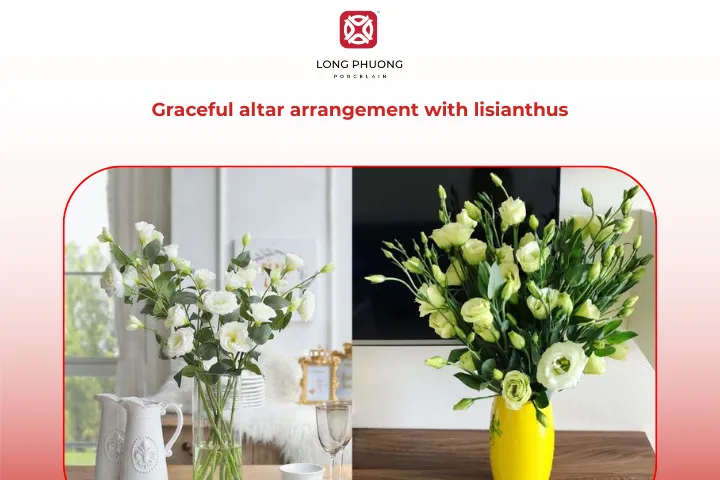
2.4 Gerbera altar arrangement for wealth and prosperity
Gerbera symbolizes wealth, luck, and happiness. Placing them on the ancestral altar is believed to attract positive energy and bring prosperity to the family. They are often arranged in tall, rounded vases, combining colors like white, red, yellow, and orange to enhance both brightness and good fortune.

2.5 Elegant altar arrangement with chrysanthemums
Chrysanthemums symbolize filial piety, longevity, and purity. On the ancestral altar, they are often arranged in round vases or upright stems, combining yellow and white blooms to create a solemn, serene, and warm atmosphere.
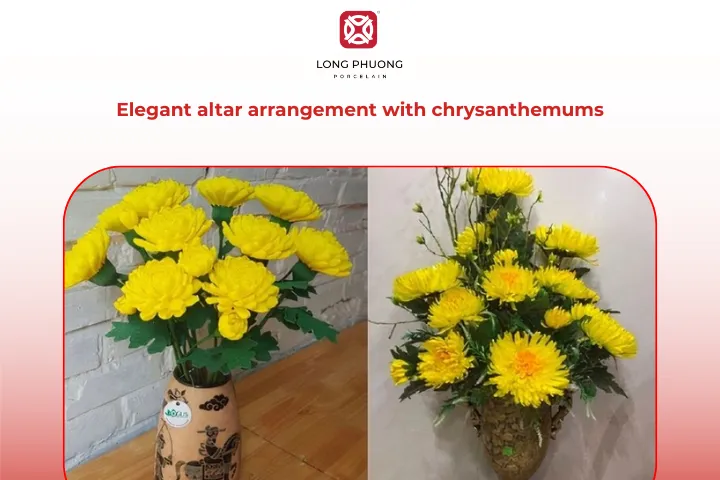
2.6 Serene altar arrangement with tuberose
Tuberose represents purity, elegance, and symbolizes innocence and nobility. Arranging tuberose on the ancestral altar adds a solemn and refined touch. You can choose white or yellow tuberose and place them in tall, neat arrangements for a graceful and sophisticated look.
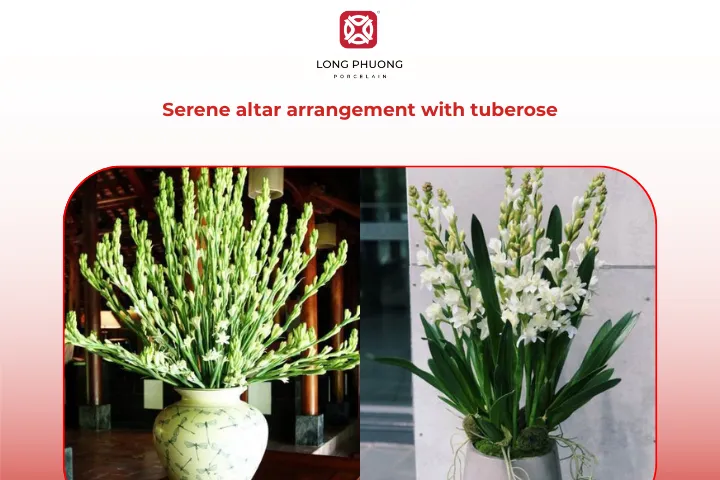
2.7 Sophisticated altar arrangement with dahlias
Dahlias symbolize abundance, luck, and prosperity. With their thick petals and vibrant colors like red, pink, yellow, and orange, they make the altar stand out while maintaining a solemn look. Dahlias are often arranged in round vases with green leaves for a harmonious and elegant display.
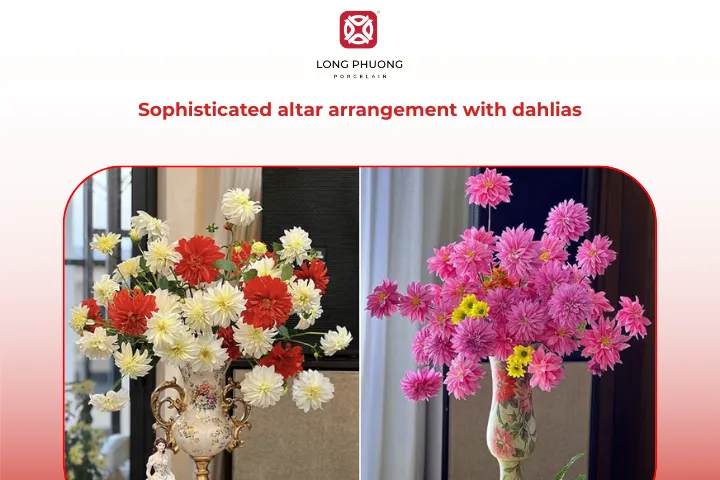
2.8 Traditional peach blossom altar arrangement for Lunar New Year
Peach blossoms symbolize spring, bringing luck, happiness, and warding off negative energy. A beautiful peach blossom arrangement for the altar during Tet represents family togetherness, well-being, and a fresh start to the new year. You can choose small branches with a natural shape, place them in a tall vase, and add a few green shoots for a lively touch.
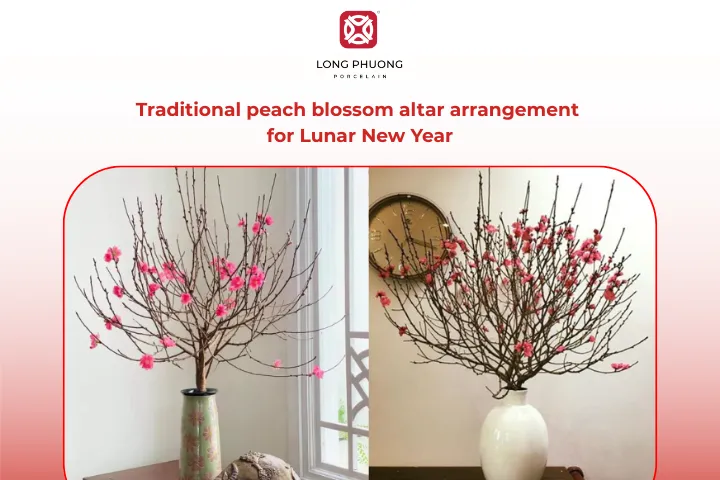
2.9 Vibrant apricot blossom altar arrangement for Lunar New Year
Apricot blossoms symbolize prosperity, wealth, and good luck. Their bright yellow color adds warmth and cheer to the altar. They are often arranged in tall vases with natural-shaped branches for an elegant and refined look.
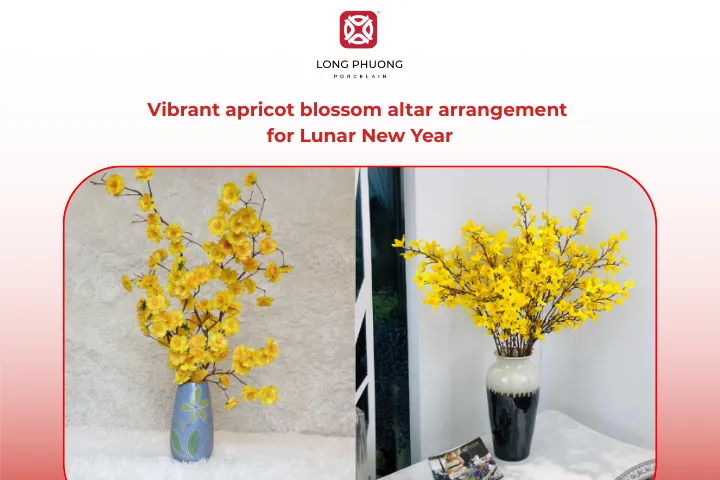
2.10 Meaningful altar arrangement with strawflower
Strawflowers symbolize longevity, enduring devotion, and filial piety. These flowers do not fade over time, representing everlasting love and respect. On the altar, they are often arranged in small vases or combined with other flowers, creating a simple yet meaningful display.
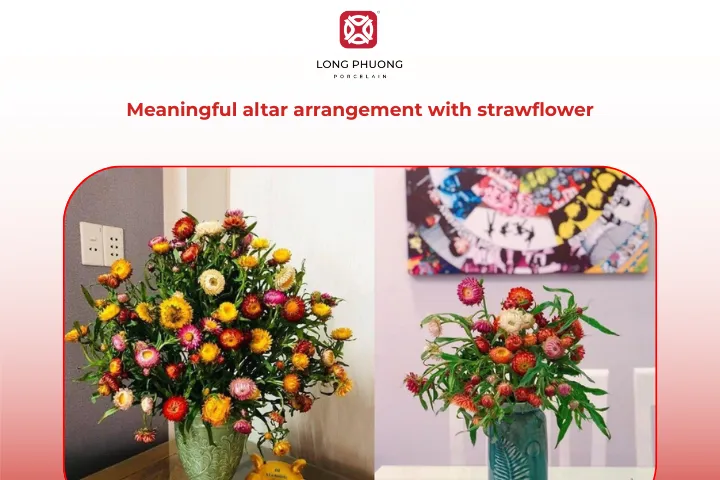
2.11 Marigold altar arrangement for longevity and blessings
Marigolds symbolize longevity, blessings, and respect for ancestors. Their bright yellow color adds warmth and solemnity to the altar. They can be arranged in round shapes or compact clusters in low vases, creating a simple yet dignified display.
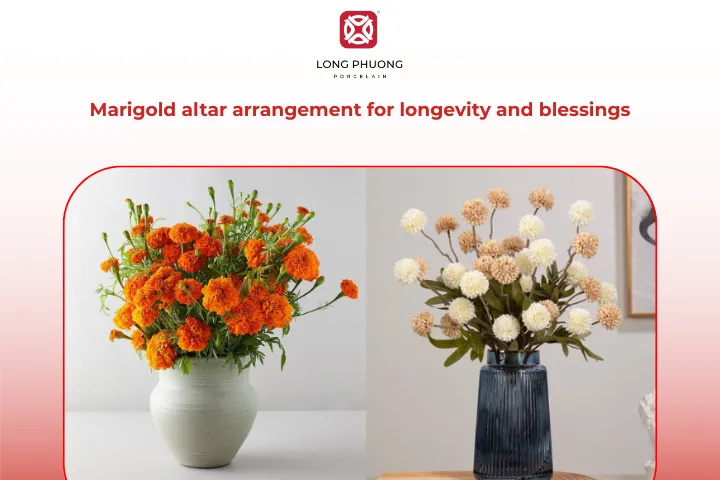
2.12 Charming altar arrangement with pussy willows
Pussy willows symbolize growth, prosperity, and good luck for the new year. Their small, colorful branches in shades of red, pink, yellow, and white add warmth and brightness to the altar. They are best arranged in tall vases, either in a single color or mixed, creating an elegant and meaningful display.
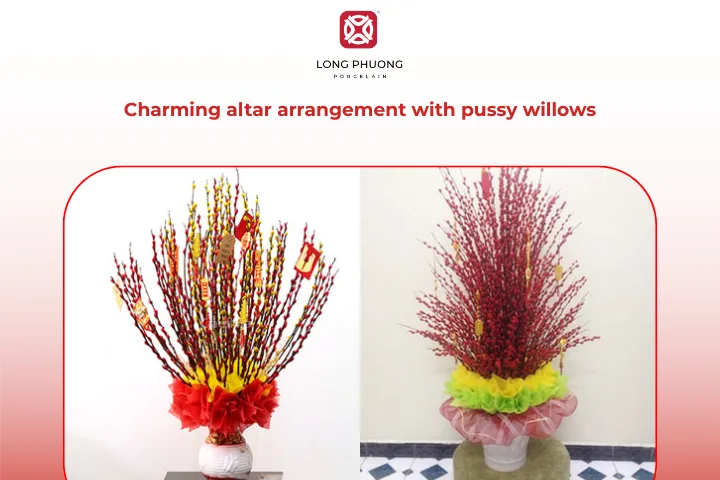
2.13. Red rose altar arrangement for luck and fortune
Red roses symbolize love and happiness. Their light, pleasant fragrance makes them ideal for altar offerings. In Feng Shui, red also represents luck and prosperity. Placing red roses on the altar during Tet is believed to invite blessings from deities, bringing wealth, success, and growth to the household.
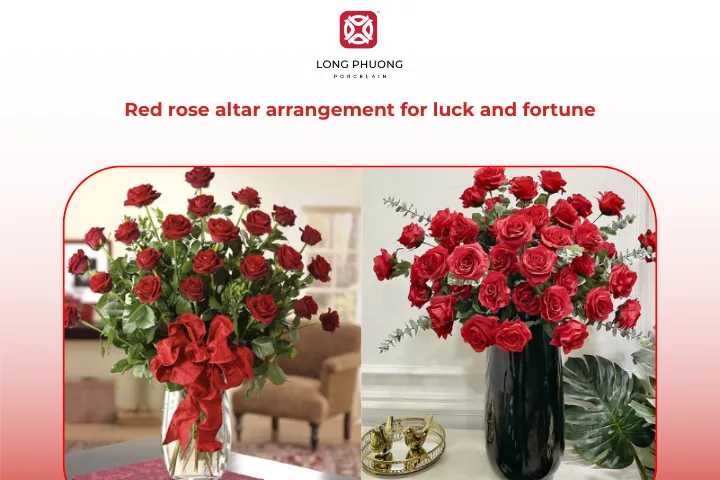
2.14. Delicate altar arrangement with peonies
Peonies, with their elegance and gentle fragrance, symbolize nobility, virtue, and compassion. Placing peonies on the ancestral altar expresses wishes for peace, happiness, and good fortune for the family. They also reflect filial piety, respect, and gratitude from descendants to their ancestors. Peonies are often used during festivals, memorial ceremonies, or other important rituals.

2.15. Luxurious altar arrangement with tulips
Tulips come in a wide range of colors and are often placed on the ancestral altar during Tet. They symbolize good luck and bring joy, happiness, and abundance to the entire family. Displaying tulips on the altar is a meaningful way to celebrate family unity and invite positive energy into the home.

3. Guide to arranging beautiful altar flowers
3.1 Preparation
- Prepare the flowers: Choose buds that are just beginning to bloom rather than fully opened flowers, as these last longer.
- Prepare the vase: Porcelain or glass vases are ideal for aesthetics and feng shui. Tall, slender vases help flowers stand upright and look graceful. For larger altars, choose bigger vases for balance. Always clean the vase before arranging flowers.

3.2 Simple ways to arrange altar flowers
Step 1: Trim the flowers
- Remove leaves from the stems that will be submerged in water to prevent them from getting dirty quickly.
- Cut stems to fit the height of the vase.
- Trim the stem ends at a 45-degree angle to help flowers absorb water better.
Step 2: Choose the layout
- Arrange flowers by height gradually to create a pyramid-like shape.
- Place the main flower stems first to form the structure.
- Fill in with smaller flowers for balance.
- Add leaves and secondary flowers to make the arrangement look full and natural.
Step 3: Add water
- Once the arrangement is complete, adjust the flowers to ensure balance and avoid leaning.
- Pour in enough water to support the flowers and place the vase on the altar.
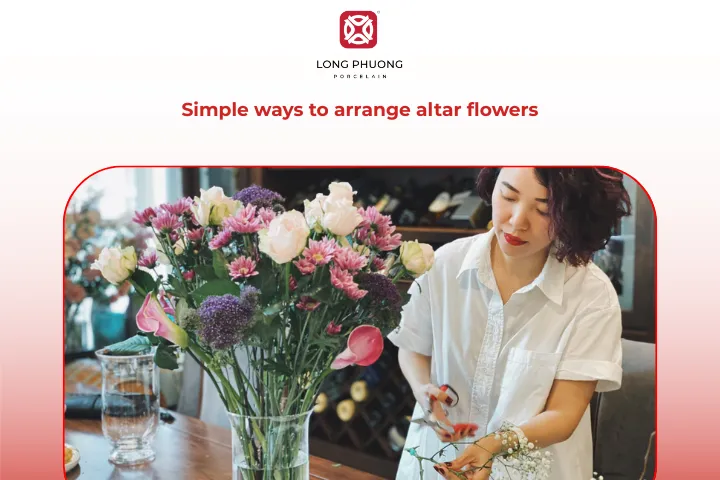
3.3 Tips to keep flowers fresh longer
- Change the water daily and add a little sugar or vitamin B1 to prolong freshness.
- Keep the vase in a cool, ventilated spot, away from direct sunlight or strong fans.
- If flowers start to wilt, trim the stems again and soak them in warm water to revive them.
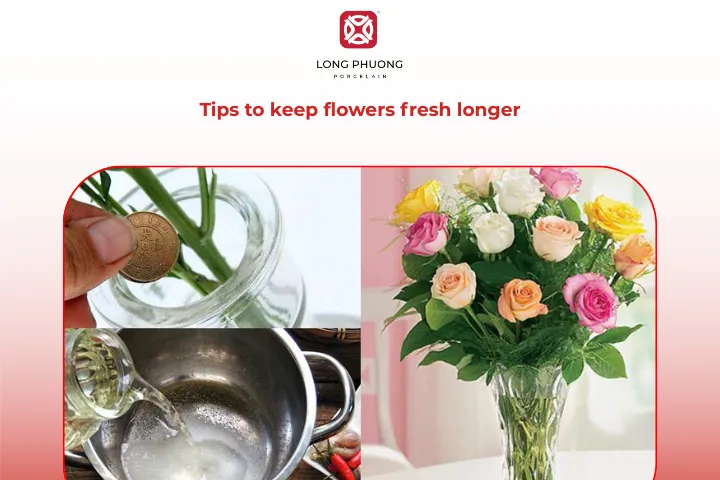
4. Which flowers should be avoided on the altar?
Arranging flowers on the ancestral altar is a way to show respect for ancestors. Not all flowers are suitable for altar offerings. Below is a list of flowers that are generally considered inappropriate or avoided.
4.1. Avoid using lilies for the ancestral altar
Although lilies are beautiful and vibrant, many people avoid arranging them on the ancestral altar or for Buddhist offerings because their name suggests separation or parting, which is considered inauspicious.
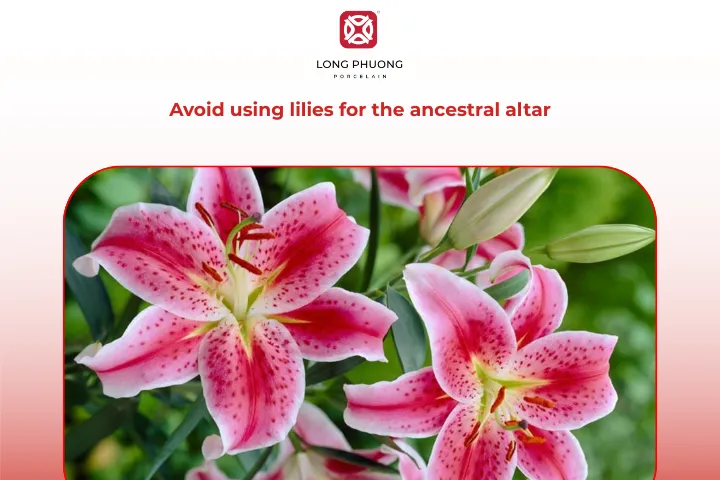
4.2. Avoid using orchids for the ancestral altar
Orchids are beautiful flowers, but the word “phong” in their Vietnamese name can be associated with indulgence or promiscuity. For this reason, many people avoid placing orchids on the ancestral altar or offering them in Buddhist rituals.

4.3. Avoid using dragon claw orchids for the altar
Dragon claw orchids have a shape that resembles a dragon’s claw, and their name carries an unfavorable meaning. For this reason, they are generally not used for ancestral worship.

4.4. Avoid using hibiscuses for the ancestral altar
Although hibiscuses are colorful and attractive, they are not used for ancestral worship because the word “dâm” in their Vietnamese name has negative connotations. Traditionally, it is associated with improper or unfaithful behavior. For this reason, most families avoid placing hibiscus on the altar.
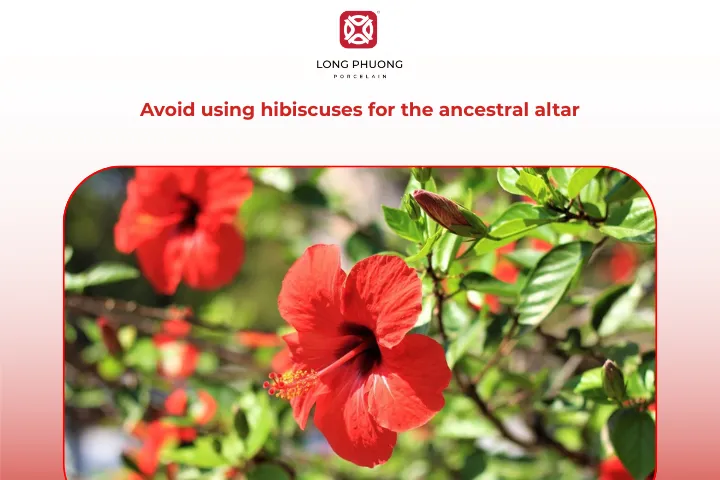
4.5. Avoid using cotton roses for the ancestral altar
Although cotton roses have a beautiful name, they wilt very quickly. Its flowers change color from pure white to pink, red, and then darken each day before withering. Due to its fleeting nature, it is considered unsuitable for ancestral worship.

4.6. Avoid using billy buttons for the ancestral altar
Billy buttons are small, charming, and brightly colored, and they even have medicinal uses. However, they are generally used for decoration only and not for ancestral worship, as their name is considered inauspicious.

4.7. Avoid using jasmines for the ancestral altar
Jasmine is fragrant and white, symbolizing purity and innocence. However, in folk beliefs, they are considered unsuitable for altar offerings, as they are thought to represent misfortune or improper behavior.

4.8. Avoid using plumeria for the ancestral altar
Plumeria are fragrant and visually appealing, but they are strictly avoided on the ancestral altar. Their shape resembles female private parts, and according to Lao folklore, they are believed to bring bad luck in romantic relationships.
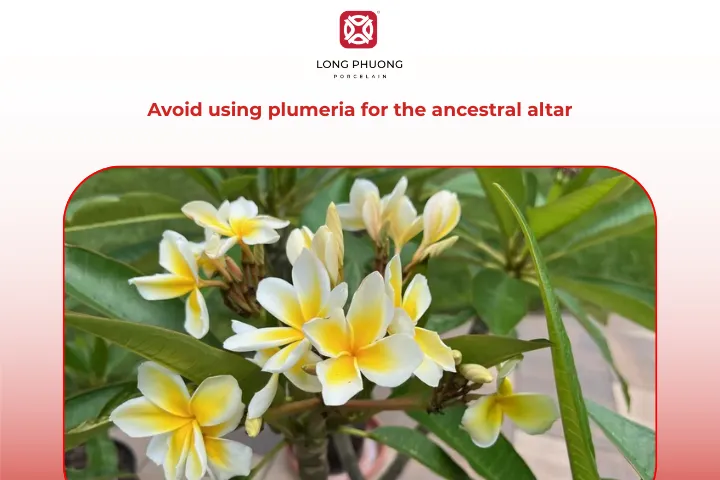
5. Important notes when arranging altar flowers
Arranging flowers on the ancestral altar properly not only enhances the serene atmosphere but also helps attract positive energy.
- Choose the right flowers: Opt for flowers that symbolize purity, good fortune, and respect. Avoid flowers with negative meanings.
- Select elegant colors: Use gentle, harmonious colors rather than overly bright or clashing tones. Avoid black or dark purple flowers as they are associated with mourning.
- Flower arrangement style: Arrange flowers in a tall and upright position for a solemn look. Do not let flowers droop or cover the incense burner, ancestral photos, or other sacred items. When placing two vases, make sure they are balanced.
- Choose an appropriate vase: Use glass or porcelain vases rather than plastic or metal, which may rust. Ensure the vase is clean and free from chips to maintain good feng shui.
- Replace flowers regularly: Remove wilted or dying flowers immediately to prevent negative energy. Keep the water clear and change it daily to help flowers stay fresh longer.
- Avoid artificial flowers: Flowers for altar offerings should be fresh and natural to maintain elegance and show respect for ancestors.
- Use paired vases: Use no more than two vases to keep the altar simple and maintain its solemn atmosphere.
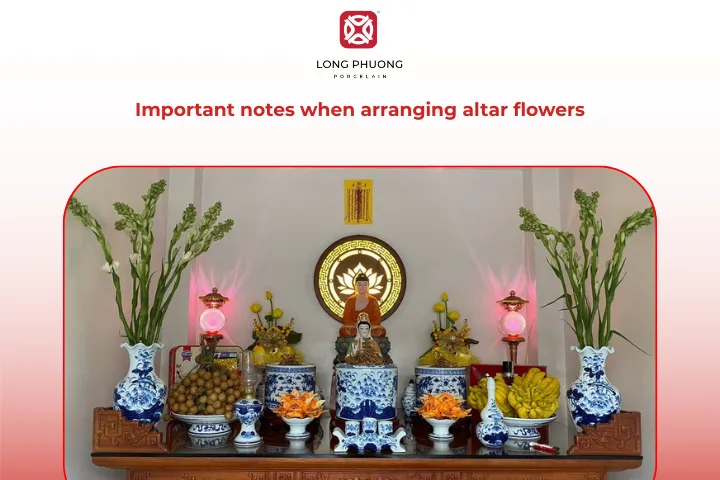
6. How to choose a flower vase for the ancestral altar
Choosing the right flower vase reflects your taste and enhances the sacred beauty of the worship space.
- Material: The vase should be made of high-quality materials like porcelain, which is valued for its classic appearance and for showing respect to ancestors.
- Shape: The vase should have an elegant design, tall with a slightly flared opening to arrange flowers neatly. A tall shape symbolizes growth and the connection between descendants and ancestors.
- Shape: The vase should have an elegant, tall design with a slightly flared opening to arrange flowers neatly. Its height symbolizes growth and the connection between descendants and ancestors.
- Color: Choose subdued, elegant colors such as white and blue with traditional patterns. These colors create a peaceful feeling and harmonize with the altar space.
- Size: The vase should be proportional to the altar. For larger altars, a tall, sizable vase works best. For smaller altars, choose a compact vase that does not overwhelm the space.
- Paired vases: In feng shui, a pair of vases on the altar symbolizes yin-yang balance and adds harmony and elegance to the space.
- Maintenance: Always clean the vase before arranging new flowers. Avoid leaving dust or dirty water in the vase, as it can affect feng shui and the purity of the altar.

7. Best popular Long Phuong’s porcelain flower vases
Long Phuong Porcelain proudly offers genuine porcelain products with high-quality glazes, diverse designs, and exquisite craftsmanship. Each piece is carefully made to ensure both aesthetic beauty and feng shui value. We are committed to providing the best porcelain items to bring luck, prosperity, and peace to your family.
7.1. Garlic-shaped porcelain vase
Long Phuong’s garlic-shaped porcelain vase brings harmony and elegance to the ancestral altar. Inspired by the garlic bulb symbolizing protection and prosperity, it enhances the sacred space with refined beauty and balance.
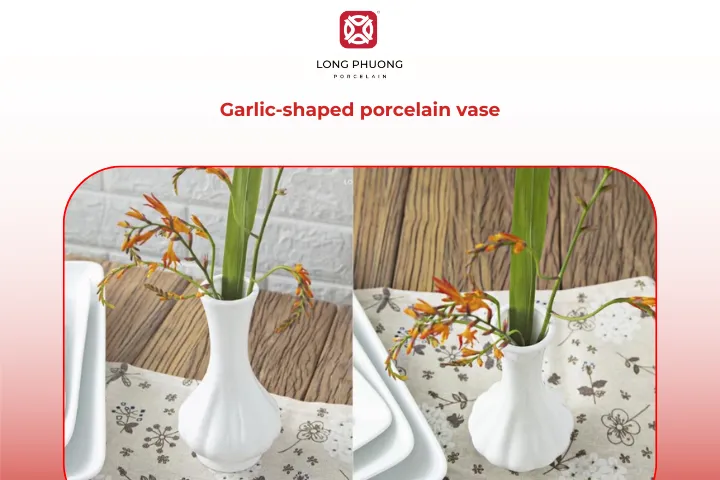
7.2. Tall porcelain vase
Long Phuong’s tall porcelain vase brings refined simplicity to the ancestral altar. Its slender form and smooth white finish create a graceful look that complements sacred spaces. The tall design adds height and harmony, making it ideal for arranging worship flowers with elegance and respect.

7.3. Son Thuy porcelain vase
With gentle curves inspired by flowing water, the Son Thuy porcelain vase symbolizes purity and harmony. Its tall, graceful shape enhances the sacred space, bringing balance and serenity. A perfect blend of artistry and meaning, this porcelain vase honors tradition with timeless elegance.
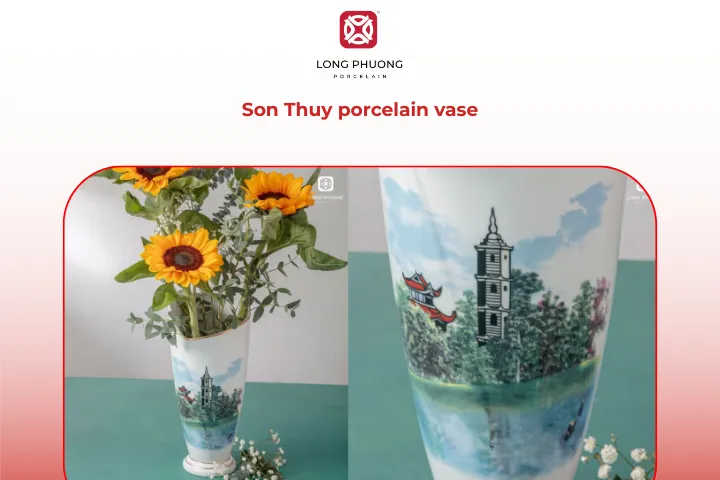
8. Frequently asked questions
8.1 Can you place different types of flowers on the altar?
Yes, but it’s best to choose flowers with harmonious colors and positive meanings. Avoid mixing too many bright colors, as it can make the arrangement look cluttered.
8.2 Is it inappropriate to place lilies on the altar?
Lilies are often avoided on ancestral altars because their name is associated with separation. However, some people still use white lilies when worshiping Buddha, as they represent purity.
8.3. Are there any special notes for arranging altar flowers during Tet?
Choose long-lasting flowers such as chrysanthemums, gladiolus, or peach blossoms. Avoid flowers that wilt quickly or carry negative meanings.
9. Conclusion
Worship rituals carry deep spiritual meaning, so it is important to choose the right flowers. The right choice not only beautifies the altar but also expresses gratitude and respect. We hope these altar flower arrangement ideas help you better understand how to select appropriate flowers and avoid common mistakes. Visit Long Phuong Porcelain to find authentic flower vases at great prices.
CEO of Long Phuong Group Joint Stock Company, with more than 20 years of exploration and research to obtain the best formulas and professional experience, Long Phuong Porcelain has produced more than 400 designs of all kinds of household porcelain, Significant contributions to Vietnam's ceramic industry.
 Vietnam
Vietnam
